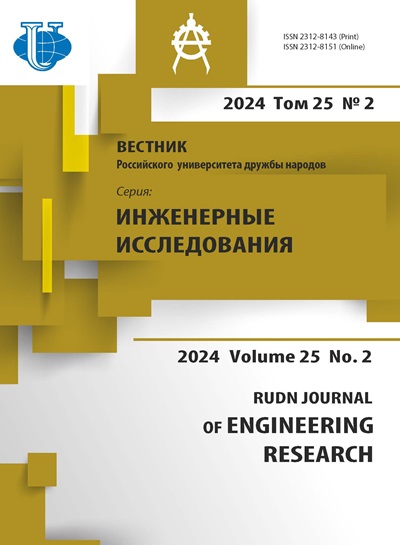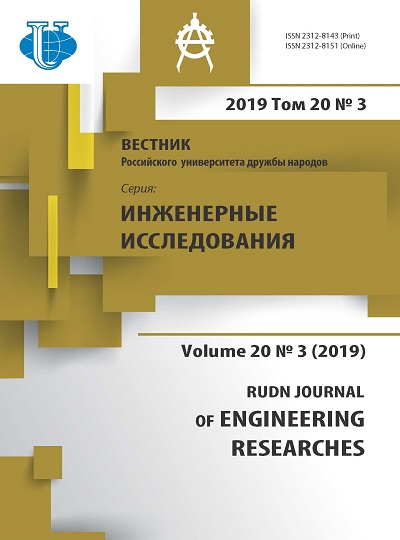Simulation of cooling of a processor in nanosatellite using the loop heat pipes
- Authors: Wang Y.1, Denisov O.V.1, Denisova L.V.1
-
Affiliations:
- Bauman Moscow State Technical University (National Research University of Technology)
- Issue: Vol 20, No 3 (2019)
- Pages: 211-219
- Section: Aviation and rocket and space technology
- URL: https://journals.rudn.ru/engineering-researches/article/view/23373
- DOI: https://doi.org/10.22363/2312-8143-2019-20-3-211-219
Cite item
Full Text
Abstract
One of the key problems in the development of nanosatellites is to provide a given temperature range for the operation of electronic equipment, the heat transfer of which can be tens of watts. Thermoregulation systems traditional for large spacecraft are not suitable for nanosatellites due to limitations on their mass and size characteristics. The indicated thermal regime of nanosatellites can be achieved using remote heat removal systems - miniature loop heat pipes. In recent years, their mass production has been established in Russia, but they have not yet found wide application in nanosatellites. The aim of the paper is to substantiate the possibility of using miniature loop heat pipes to remove excess heat from the on-board computer processor to the carbon-plastic case of the nanosatellite. Parametric modeling of the influence of geometric dimensions and the values of the effective thermal conductivity coefficient of loop heat pipes on the processor temperature was carried out in the ANSYS program. Calculations showed that the use of contour heat pipes will reduce the processor temperature to acceptable values. The anisotropy of the thermal conductivity coefficient in the reinforcement plane of the composite material of the nanosatellite case can have a significant effect on the temperature of the processor. This opens up prospects for the use of anisotropic composite materials to ensure the thermal regime of the nanosatellite.
About the authors
Yu Wang
Bauman Moscow State Technical University (National Research University of Technology)
Author for correspondence.
Email: denisov.sm13@mail.ru
master student of the Department SM13 “Rocket and Space Composite Structures”
5 2-ya Baumanskaya St., bldg. 1, Moscow, 105005, Russian FederationOleg V. Denisov
Bauman Moscow State Technical University (National Research University of Technology)
Email: denisov.sm13@mail.ru
associate professor of the Department SM13 “Rocket and Space Composite Structures”, Candidate of Technical Sciences
5 2-ya Baumanskaya St., bldg. 1, Moscow, 105005, Russian FederationLiliana V. Denisova
Bauman Moscow State Technical University (National Research University of Technology)
Email: denisov.sm13@mail.ru
associate professor of the Department SM13 “Rocket and Space Composite Structures”
5 2-ya Baumanskaya St., bldg. 1, Moscow, 105005, Russian FederationReferences
- Makridenko LA, Boyarchuk KA. Mikrosputniki. Tendentsii razvitiya. Osobennosti rynka i sotsial’noe znachenie [Microsatellites. Development trend. Market features and social significance]. Voprosy elektromekhaniki. 2005;102:12–27. (In Russ.)
- San Francisco: Nanosatellite and Microsatellite Market Analysis Report By Mass, By End Use (Defense & Security), By Application (Communication & Navigation, Scientific Research), And Segment Forecasts, 2019–2025. Grand View Research. Available from: www.grandview research.com/industry-analysis/nanosatellite-microsatellitemarket (Accessed May 2019).
- Blinov VN, Ivanov NN, Sechenov YuN, Shalai VV. Malye kosmicheskie apparati: v 3 kn. Kn. 3. Minisputniki. Unifitsirovannye kosmicheskie platformy dlya malykh kosmicheskikh apparatov [Small space vehicles: in 3 books. Book 3. Minisatellite. Unified space platforms for small space vehicles]: reference book. Omsk: OmSTU Publishing Office; 2010. (In Russ.)
- Nikolskii VV. Proektirovanie sverhmalih kosmicheskih apparatov [Designing of ultra-small spacecrafts]: training manual. Saint Petersburg: Baltic State Technical University; 2012. (In Russ.)
- Chebotarev VE, Kosenko VE. Osnovi proektirovaniya kosmicheskih apparatov informatsionnogo obespecheniya [The basics of designing a spacecraft information support]: tutorial. Krasnoyarsk; 2011. (In Russ.)
- Tsaplin SV, Bolychev SA. Issledovanie teplovih rezhimov optiko-elektronnogo teleskopicheskogo modulya v usloviyah ekspluatatsii [Investigation of the thermal conditions of the optoelectronic telescopic module of a nanosatellite in operating conditions]. Vestnik of Samara University. Aerospace and Mechanical Engineering. 2019;(2): 96–111. (In Russ.)
- Modern mobile technology. Available from: https:// www.notebook-center.ru/processor_tdp.html
- Dunn PD, Reay DA. Heat Pipes. Oxford – New York – Toronto – Sydney – Paris – Braunschweig: Pergamon Press; 1976.
- Maydanik YuF. Dostizheniya i perspektivi razvitiya konturnih teplovih trub [Achievements and development prospects of loop heat pipes]. Proc. of 4th Conf. on Heat Mass Transfer. Moscow. 2006. p. 84–92. (In Russ.)
- Maydanik YuF. Konturnie teplovie trubi – visokoeffektivnie teploperedauyshie ustroistva dlya ohlazhdeniya elektroniki [Loop Heat Pipes: highlyefficient heat transfer devices for cooling systems of electronics]. Electronics: Science, Technology, Business. 2017;(6):122–130. (In Russ.)
- Maydanik YuF., Vershinin SV, Chernysheva MA. Razrabotka i issledovanie ammiachnoi miniaturnoi konturnoi teplovoi trubi pri razlichnih vneshnih uslovieah [Development and Research of Ammonia Miniature Loop Heat Pipe under Various External Conditions]. Journal of Thermal Processes in Engineering. 2016;(7):312–320. (In Russ.)
- Mikhailovskii KV, Prosuntsov PV, Reznik SV. Razrabotka visokoteploprovodnih polimernih kompozitsionnih materialov dlya kosmicheskih konstruktsii [Development of high-conductivity polymer composite materials for space structures]. Vestnik MGTU imeni N.E. Baumana. Seriya: Mashinostroenie. 2012;(9):98–106.(In Russ.)
- Ren Chuan, Wu Qing-Song, Hu Mao-Bin. Heat transfer with flow and evaporation in loop heat pipe’s wick at low or moderate heat fluxes. International Journal of Heat and Mass Transfer. 2007;50(11–12):2296–2308.
- Ageenko AV, Maziuk VV. Metod rascheta poroshkovoi kapillyarnoi strukturi isparitelya konturnoi teplovoi trubi s perevernutim meniskom [Theoretical Calculation Method for Powder Capillary Structure of Loop Heat Pipe with Inverted Meniscus]. Science & Technique. 2011; (4):20–25. (In Russ.)
- Nikolaev GP, Izoteeva OYu. Raschet rabochih harakteristik konturnih teplovih trub [Calculation of performance characteristics of loop heat pipes]. Molodoi Ucheniy. 2012;3(38):17–25. (In Russ.)
- Afanas’ev VN, Nedaivozov AV, Yakomaskin AA. Eksperimental’noe issledovanie protsessov v konturnih teplovih trubah [Experimental Study of Processes in Loop Heat Pipes]. Vestnik MGTU imeni N.E. Baumana. Seriya: Mashinostroenie. 2014;(2):44–61. (In Russ.)
- Pozhilov AA, Zaitsev DK, Smirnov EM, Smirnovsky AA. Chislennoe modelirovanie teplomassoperenosa v trehmernoi modeli isparitelya konturnoi teplovoi trubi [Numerical simulation of heat and mass transfer in a 3D model of a loop heat pipe evaporator]. Saint Petersburg Polytechnical State University Journal. Physics and Mathematics. 2017;10(3):52–61. doi: 10.18721/JPM.10305. (In Russ.)
- Chernysheva MA, Vershinin SV, Maydanik YF. Operating Temperature and Distribution of a Working Fluid in LHP. International. Journal of Heat and Mass Transfer. 2007;50(13–14):2704–2713.
- Derevyanko VA, Nesterov DA, Kosenko VE, Zvonar VD, Chebotarev VE, Fatkulin RF, Suntsov SB. Ploskie teplovie trubi dlya otvoda tepla ot elektronnoi apparaturi v kosmicheskih apparatah [Flat heat pipes for heat removal from electronic equipment in space vehicles]. Siberian Journal of Science and Technology. 2013; 6(52):111–116. (In Russ.)
- Reznik SV, Prosuntsov PV, Denisov OV, Petrov NM, Shulyakovsky AV, Denisova LV. Raschetno-eksperimental’noe opredelenie teploprovodnosti ugleplastika v ploskosti armirovaniya na osnove beskontaktnogo izmereniya temperature [Numerical and experimental estimation of heat conductivity of carbon plastic in a reinforcement plane on the basis of contactless measurement of temperature]. Journal of Thermal Processes in Engineering. 2016;(12):557–563. (In Russ.)
- Reznik SV, Prosuntsov PV, Denisov OV, Petrov NM, Vonheong Lee. Raschetno-eksperimental’naya metodika opredeleniya teploprovodnosti kompozitsionnogo materiala korpusa nanosputnika [Nanosatellite body composite material thermal conductivity determination computational and theoretical method]. RUDN Journal of Engineering Researches. 2017;18(3):345–352. DOI 10.22363/ 2312-8143-2017-18-3-345-352. (In Russ.)
















